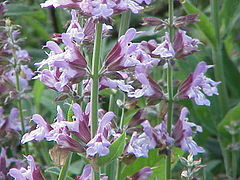
Salvia officinalis
Did you know...
This selection is made for schools by a children's charity read more. SOS Children is the world's largest charity giving orphaned and abandoned children the chance of family life.
| Common sage | |
|---|---|
 |
|
| flowers | |
| Scientific classification | |
| Kingdom: | Plantae |
| Division: | Magnoliophyta |
| Class: | Magnoliopsida |
| Order: | Lamiales |
| Family: | Lamiaceae |
| Genus: | Salvia |
| Species: | S. officinalis |
| Binomial name | |
| Salvia officinalis L. |
|
Common sage (Salvia officinalis) is a small evergreen subshrub, with woody stems, grayish leaves, and blue to purplish flowers. It is native to the Mediterranean region.
It is much cultivated as a kitchen and medicinal herb. Common sage is also grown in parts of Europe, especially the Balkans for distillation of the essential oil, though other species, such as Salvia triloba may also be harvested and distilled with it.
It is also called Garden sage, Kitchen sage, and Dalmatian sage. The word sage or derived names are also used for a number of related and non related species.
Culinary uses
As a herb, sage is considered to have a slight peppery flavour. In Western cooking, it is used for flavouring fatty meats (especially as a marinade), cheeses (Sage Derby), and some drinks. In Britain and Flanders, sage is used with onion for poultry or pork stuffing and also in sauces. In French cuisine, sage is used for cooking white meat and in vegetable soups. Germans often use it in sausage dishes, and sage forms the dominant flavouring in the English Lincolnshire sausage. Sage is also common in Italian cooking. Sage is sautéd in olive oil and butter until crisp, then plain or stuffed pasta is added (burro e salvia). In the Balkans and the Middle East, it is used when roasting mutton.
Medicinal use
Actions
The Latin name for sage, salvia, means “to heal". Although the effectiveness of Common Sage is open to debate, it has been recommended at one time or another for virtually every ailment. Modern evidence supports its effects as an antihydrotic, antibiotic, antifungal, astringent, antispasmodic, estrogenic, hypoglycemic, and tonic. In a double blind, randomized and placebo-controlled trial, sage was found to be effective in the management of mild to moderate Alzheimer's disease.
Active constituents
The strongest active constituents of Sage are within its essential oil, which contains cineole, borneol, and thujone. Sage leaf contains tannic acid, oleic acid, ursonic acid, ursolic acid, cornsole, cornsolic acid, fumaric acid, chlorogenic acid, caffeic acid, niacin, nicotinamide, flavones, flavone glycosides, and estrogenic substances.
Cultivars
A number of cultivars of the plant exist. The majority of these are cultivated more often for ornament than for their herbal properties. All are valuable as small ornamental flowering shrubs, and for low ground cover, especially in sunny dry situations. They are easily raised from summer cuttings. Named cultivars include
- 'Purpurascens', a purple-leafed cultivar, considered by some to be strongest of the garden sages,
- 'Tricolor', a cultivar with white, yellow and green variegated leaves,
- 'Berggarten', a cultivar with large leaves,
- 'Icterina', a cultivar with yellow-green variegated leaves,
- 'Alba', a white-flowered cultivar,
- 'Extrakta', has leaves with higher oil concentrations.
- 'Lavandulaefolia', a small leaved cultivar.


